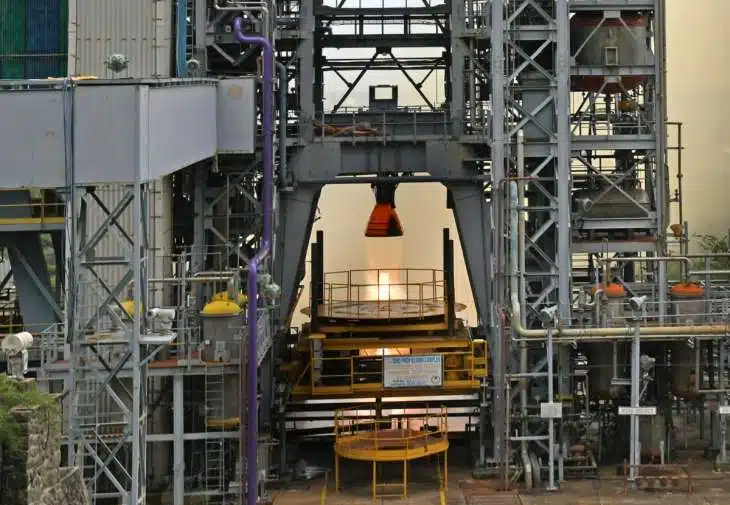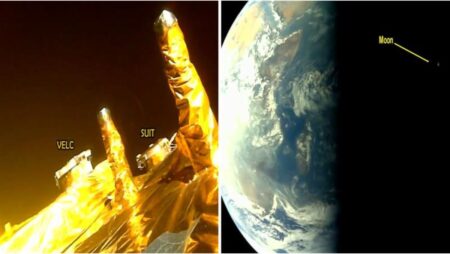On January 20, the Indian Space Research Organisation (ISRO) successfully completed a qualification test of its High Thrust VIKAS Engine at the ISRO Propulsion Complex (IPRC) in Mahendragiri, Tamil Nadu. In order to get ready for the Gaganyaan mission, which will launch later this year, the engine was fired for 25 seconds.

ISRO Successfully Tests Vikas Engine Beyond Nominal Operating Parameters
According to ISRO, the engine performed as expected during the test, and its parameters nearly matched what the engineers had predicted. In their report, ISRO stated that the purpose of the test was to “check the robustness of the engine by operating beyond its nominal operating parameters.”
The engine’s Gimbal Control system was created by VSSC, and the Liquid Propulsion Systems Centre (LPSC) designed the engine. The engine has enhanced assembly techniques, higher structural tolerances for sub-systems, and more measurements for health monitoring. It operates on storable propellants in a pump-fed gas generator cycle.
The agency will then conduct three further tests with a total duration of 75 seconds under various operational settings. Before the Vikas engine qualifies for the Gaganyaan Program, another 240-second test of the engine will be conducted after that.As two engines had already been tested for a total of 480 seconds in nominal operating circumstances, the most recent test was the third successful qualifying test.
The test conducted on Thursday aimed to confirm the engine’s durability by working outside of its intended operational parameters (fuel-oxidiser ratio and chamber pressure).Throughout the entire test, the engine’s performance complied with the goals set forth for it, and its parameters nearly followed the forecasts.

For the Gaganyaan mission, ISRO also tested the Crew Module Propulsion System using a System Demonstration Model (SDM).At the ISRO Propulsion Complex at Mahendragiri, a hot test was carried out to demonstrate the nominal re-entry over a time period of 650 seconds. Before the demonstration, a series of experiments were run with six thrusters.
The crew module and the astronauts will be securely guided and slowed down by the propulsion system as they re-enter the Earth’s atmosphere in preparation for a safe splashdown.
Previous to the most recent qualification test, ISRO had also used the Gaganyaan mission to fire its cryogenic engine for 720 seconds. As opposed to solid and liquid propellants that can be stored on Earth, cryogenic engines use liquid oxygen and hydrogen at -196°C and -250°C, respectively, and offer greater efficiency and thrust. The launch vehicles intended to send Indian astronauts to space in 2024 will reportedly use these engines, according to ISRO.
Three launches will be made by ISRO as part of the project, two of which will be unmanned, beginning in the second half of 2022. It’s interesting to note that the second unmanned launch will send an ISRO-built space robot named “Vyommitra” into orbit, where it will collect data before the third launch of real astronauts.
The ISRO Propulsion Complex (IPRC) at Mahendragiri, Tamil Nadu, is where the Vikas engine for the Gaganyaan/human space mission passed the qualification test, according to ISRO.

Gaganyaan, which was delayed by the Covid-19 pandemic and subsequent lockdowns, will be introduced in 2024. Dr. Jitendra Singh, India’s Minister of Science and Technology, had previously stated that the country would launch its first human space mission in 2024, making it the fourth country in the world to do so, behind the US, Russia, and China.
The first uncrewed mission of Gaganyaan and the test vehicle flight to validate the performance of the Crew Escape System are slated to launch at the start of the second half of 2022.According to Isro, “This successful long-duration test is a significant milestone for the Human Space Project Gaganyaan.”
Read more on: https://www.isro.gov.in/Vikas_engine_test_campaign.html













